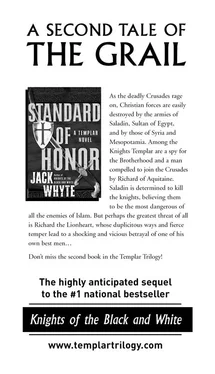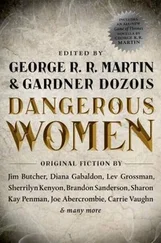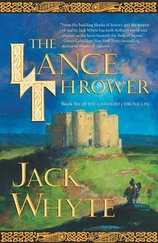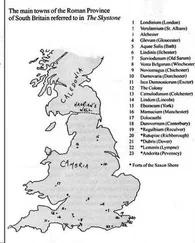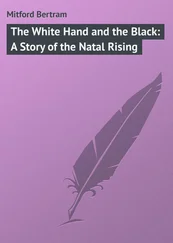The third sconce from the wall turned in St. Clair’s hand as he tugged at it, and as he snatched at the torch that tumbled from it, they both heard the same subterranean rumble they had heard earlier, when the first door opened, except that this time it was closer and not at all muffled, as the blank end wall sank slowly into the floor.
Stretching across the cavity revealed a heavy curtain of richly embroidered cloth hung from a thick rod, the colors in the pattern still bright in the torchlight. For a long space neither man moved or appeared to breathe, but finally de Montbard took a tentative step forward, stretching his hand out cautiously to touch the cloth. St. Clair stood spellbound, watching the hanging fabric stir beneath that questing hand until suddenly de Montbard seized the curtain and thrust it violently to one side, letting the light from their torches spill into the darkness beyond.
In spite of himself, St. Clair leapt in fright and uttered a strange, high-pitched sound, then fell to his knees as though he had been smashed with a mace. Beside him, de Montbard reacted similarly, grunting an unintelligible sound, but remaining on his feet despite the shock.
In front of them, awash in the light of the torches they had lit, stretched a chamber as large as the one in which they stood; a long, narrow space of two contrasting colors, black and white. It was a perfect replica of the temples, the ritual gathering places, they had known at home in Christendom, from the alternating marble tiles of black and white upon the floor, to the draped thrones on either side of where they now stood staring into the chamber’s depths, to the twin pillars between which they had sworn their oaths. They saw and recognized all of it, and yet each of them knew, within the echoing stillness of his own mind, that this place, this temple, had been shut up in darkness for thousands of years, awaiting their arrival.
De Montbard was the first of them to gather his wits—probably, St. Clair found himself thinking to his own surprise, because he had known enough beforehand to suspect what might be here. He stepped into the chamber slowly, holding a flaming torch high above his head, and St. Clair went with him, matching him step for step and willing his pounding heart to slow down.
“We are in the West,” de Montbard said.
“Aye, and facing towards the East,” St. Clair responded, barely aware of repeating the ritual words, “where all shall be revealed.”
They moved forward together, stepping out resolutely until they were confronted by another curtain, much like the first but narrower. They exchanged glances, and de Montbard reached out yet again and, more cautiously and reverently this time, pulled the curtain aside. Beyond this veil, reflecting the light of their torches in a golden blaze, was something magnificent but unidentifiable: an elongated rectangular shape, solid and substantial and somehow more elaborate—this in defiance of all logic—than any single object St. Clair could ever remember having seen. It took him several more moments to understand that he was looking at an ornate golden chest, and he estimated its size to be about four feet in length by half that in height and width. It was topped with a complex, unrecognizable sculpture, also of gold, and two long, golden poles, held in place by heavy gold rings on each side, were obviously the means of carrying it from place to place. The sheer splendor of it filled St. Clair’s entire being with an awe that was almost religious, and for long minutes he simply stood and stared at it, aware that de Montbard was kneeling motionless in front of him, like a man in a trance. He had not seen de Montbard pass him or sink to his knees, but he was not surprised by any of that; since the moment the curtain had been pushed aside, St. Clair had been aware of nothing but the chest. Now he felt a need to move. And he willed himself to go forward, one small step at a time, until he was standing beside the kneeling man. His eyes filled with the golden glory of the thing in front of him, he reached down with one hand to grasp de Montbard’s shoulder.
“What is it?” He heard the timidity and awe in his own voice, but his question seemed to break the trance that gripped the other man, for he reached up and grasped St. Clair’s arm, using it to pull himself upright. When he was on his feet, he walked backward, pulling St. Clair with him, to the curtain, and he closed it once again, reverently, concealing the golden chest from view. That done, they continued to back away, looking neither to right nor left, until they reached the foot of the stairway leading to the Hall above. Only there did they turn, to run up the steps to the darkness of the great chamber, and only then, safely out of the other place, did they stop and turn to stare at each other, wide eyed.
“I did not believe,” Montbard said then, in a shaky voice. “I did not believe it could be true.”
St. Clair was breathing heavily, although he could not have told anyone why. “ What could be true?” he asked. “What are you talking about? What is that thing?”
Now de Montbard gaped at him. “You don’t know? You don’t know what we have found? This is the Order’s treasure, Stephen, but a real treasure, spoken of in the Lore but never mentioned as being present here. A treasure greater than any of us could ever have suspected. It is the Ark, Stephen. We have found the Ark.”
St. Clair stood frowning, uncomprehending, aware only of his companion’s profound awe. “What Ark?”
“ The Ark, Stephen. The Ark of the Covenant, the repository of God’s covenant with humanity. It was kept in the Holy of Holies, in the temple. It is the symbol of God Himself …”
He turned to face St. Clair, his eyes glowing with conviction. “We have to tell the others, Stephen, now, immediately, for this changes everything. This will change the entire world. Nothing will ever be the same again. This is the reason for our Order’s formation a thousand years ago.”
St. Clair shook his head as though to clear it. “The Ark of the Covenant? I thought our treasure was no more than written records. But now you are telling me that this thing we have found is the Ark of the Covenant ? From the Holy of Holies? Then I want to look at it again.” He ran swiftly down the steps, uncaring whether de Montbard came with him or not, but by the time he paused hesitantly in front of the concealing curtain, he was aware of the other man at his shoulder. He reached out slowly and pushed the curtain aside carefully, hearing the curtain rings slowly sliding along the rod, and then he stood, gazing solemnly at the Ark, marking the way the flickering of their torches was reflected in the lines of the golden surface.
“Solid gold,” he said some time later, his voice barely louder than a whisper.
“No, I think not,” de Montbard demurred. “The lid is solid gold. But I believe the chest and the carrying poles are carved from setim —an imperishable acacia wood—then coated with a covering of pure gold. Were the entire thing made of solid gold, it would be too heavy to carry.”
“What about the winged things on the top?”
“Cherubim, cherubs, angels—winged spirits of great power. You see how their wings are spread out and touching each other? They form a protective canopy over the lid of the Ark itself. The ancient Jews believed that God, the God of Moses, lives within that space.”
“Not in the Ark itself?” St. Clair’s face betrayed his surprise.
“No, in the space beneath the wings of the cherubim.”
“But those are graven images. The Jews were forbidden to have those.”
Montbard shrugged, his eyes still on the carvings. “Apparently they made an exception, just this once.”
Читать дальше
Конец ознакомительного отрывка
Купить книгу
